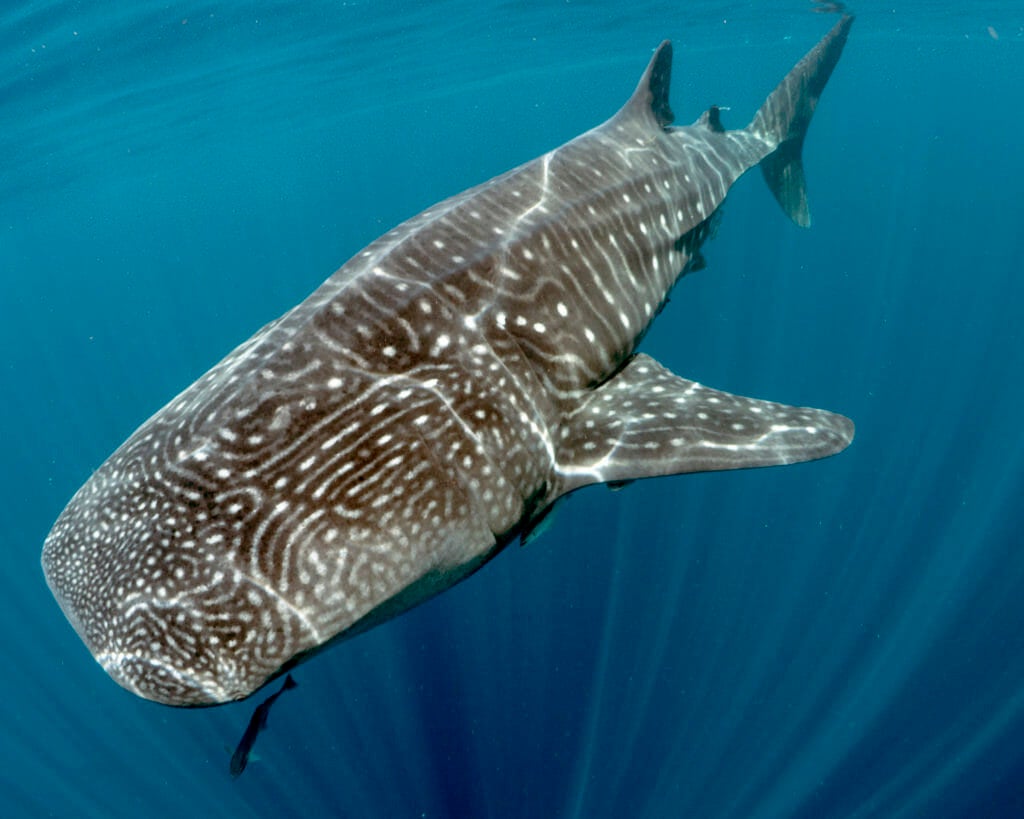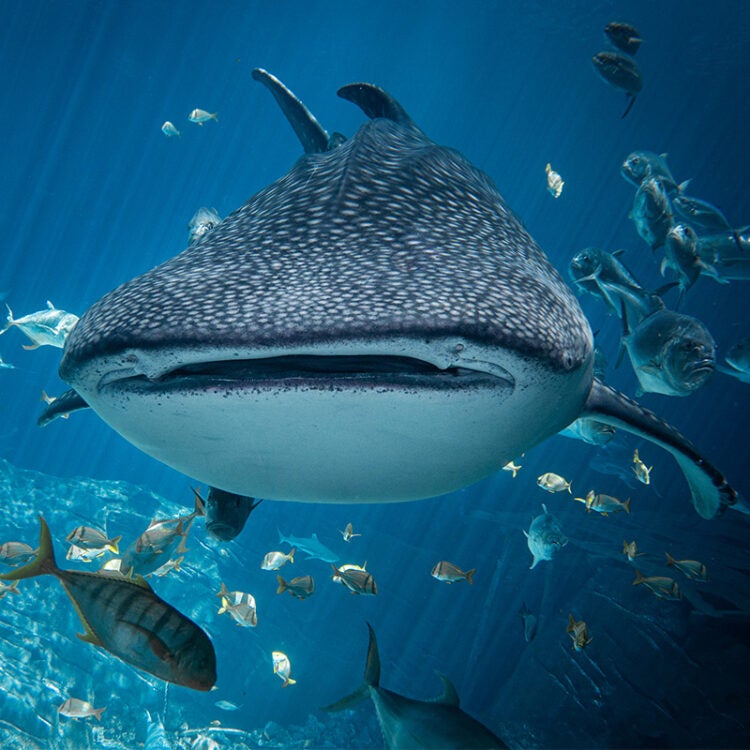-
Size
18-32 feet (5.5-9.8 m) -
Diet
Zooplankton -
Range
Tropical Atlantic, Pacific, and Indian Oceans -
Habitat
Typically found offshore
Physical Characteristics
Size
- The whale shark is the largest fish in the world and the largest fish known to have lived on this planet. Because of its size and cartilaginous skeleton, it does not fossilize well and in life it is very difficult to weigh accurately.
- The largest accurately measured whale shark was 61.7 feet (18.8 m).
- The average length is between 18 and 32 feet (5.5-9.8 m).
- Newborns measure 21 to 25 inches (53-64 cm) long.
Body Composition
- Whale sharks have a broad, flat head, relatively small eyes, five large gill slits, two dorsal fins, two long pectoral fins, two pelvic fins, one anal fin and a large sweeping tail. It has a vestigial spiracle behind the eye, which is an evolutionary remnant of its common ancestry with bottom-dwelling (benthic) carpet sharks.
- Unlike most shark species, its mouth is located at the front of the head (terminal) instead of the underside of the rostrum (subterminal).
- The whale shark has a huge mouth, which can reach up to 4 feet (1.2 m) across, located at the front of the head.
- Inside the mouth are specialized flaps called velums. These stop the backflow of water as the whale shark closes its mouth, preventing the loss of food.
- The skin of an adult whale shark can be as thick as 4 inches (10 cm) and has the consistency of strong rubber, which limits possible predators to killer whales, great white sharks, tiger sharks and humans.
Color
- Whale sharks have a two-toned pattern of light spots on their dark gray back with a white underside.
- Each whale shark has its own individual spot pattern; like human fingerprints, no two are exactly alike.
Teeth
- The teeth of the whale shark are tiny and pointed backward; they are thought to have no function in feeding.
- There are about 300 rows of tiny teeth along the inner surface of each jaw, just inside the mouth.
Animal Fact
Whale sharks’ mouths can reach up to 4 feet (1.2 m) across.
Diet / Feeding
Diet
- Consists of zooplankton, specifically sergestid shrimps and fish eggs as well as krill, jellies, copepods, coral spawn, etc. and small fishes (sardines, anchovies, etc).
- Can only swallow small prey because its throat is very narrow, often compared to the size of a quarter.
Feeding Behaviors
- A whale shark filters food from the water by “cross-flow filtration,” which means the particles do not catch on the filter. Rather, water is directed away through the gills while particles (which have more momentum) carry on toward the back of the mouth in an ever more concentrated stream. A bolus or spinning ball of food grows in diameter at the back of the throat until it triggers a swallowing reflex. This is very efficient and does not clog the filters.
- Multiple feeding methods may be observed in whale sharks:
- When food concentrations are high, the shark will use one of two suction-type feeding methods: active suction feeding and vertical suction feeding.
- Active surface suction feeding is the most common type of feeding method and is characterized by the shark swimming in a normal orientation while feeding.
- When food is densely concentrated, the shark will often exhibit vertical suction feeding: remaining stationary in a semi-vertical position, facing the surface.
- During vertical and active surface suction feeding, the shark will open and close its mouth, creating a strong suction and bringing in large volumes of water.
- When the sharks are fed in Ocean Voyager, they employ this suction-type feeding style, while following feeding ladles along the surface.
- During active surface feeding, the top jaw typically breaks the surface.
Range / Habitat
Range
- Occurs worldwide in the tropical Atlantic, Pacific, and Indian Oceans between about 30 degrees North and 35 degrees South, though it has been sighted as far as 41 degrees North and 36.5 degrees South.
Habitat
- Typically found offshore but will come close to shore, sometimes entering lagoons or coral atolls. Frequents shallow water areas near bays and upwelling coastal areas near continental drop-offs, sometimes during seasonal plankton blooms.
Reproduction & Growth
- Ovoviviparous- the embryo is formed within an egg, which then hatches in the mother’s uterus. At term, the young are released into the sea fully formed. The only litter size that has ever been documented was more than 300 pups.
- Very little is known about whale shark mating behavior as it has been observed only twice in its natural habitat, and never in an aquarium setting.
Conservation Status
- “Endangered” on the IUCN Red List.
- Appendix II of CITES.
- Appendix II of CMS
- In 2016, the global whale shark population as a whole was downgraded from Vulnerable to Endangered on the IUCN Red List.
- Specific threats to whale sharks include entanglement in fishing nets, boat strikes, ingestion of marine debris and micro plastics, and in some cases human interference through unregulated tourism.
- In southern China and Oman, whale sharks are opportunistically fished.
Additional Information
- The usual swim speed when feeding at the surface is roughly 2 knots (a typical walking pace of 2.3 mph). When cruising, it averages about 2.5 knots (2.9 mph). When alarmed, the whale shark has been observed accelerating to a body length per second for very short bursts, but they cannot sustain fast swimming for long.
Sources
- Sharks & Rays. Hennemann, R. M.
- www.fishbase.org
- www.iucnredlist.org
- www.flmnh.ufl.edu
Unique Gifts from Georgia Aquarium
Bring the memories home with you! Stop by our gift shop for all your whale shark gifts or shop online here.







